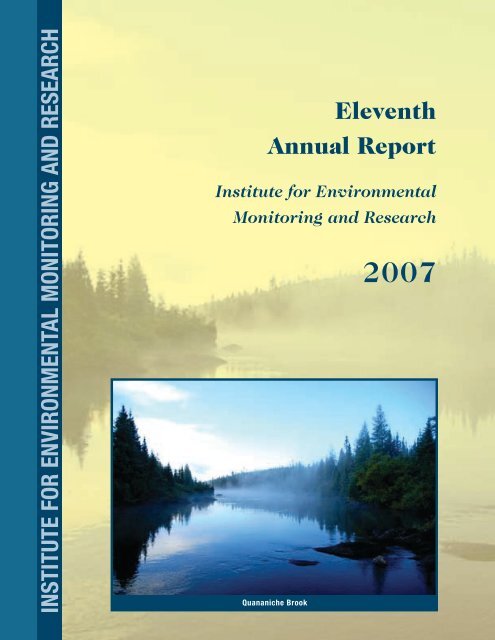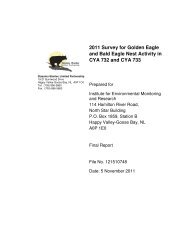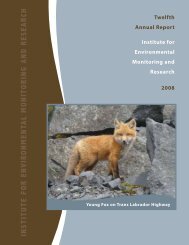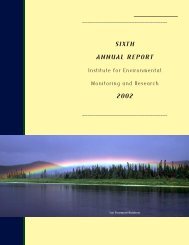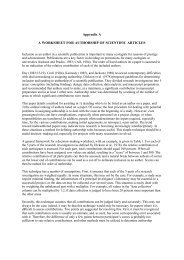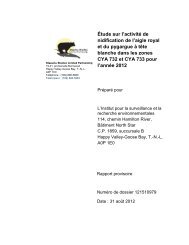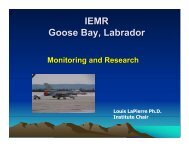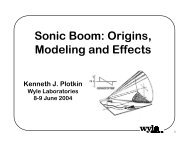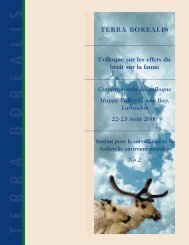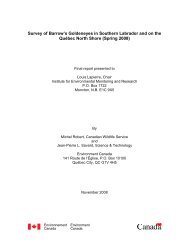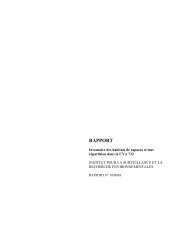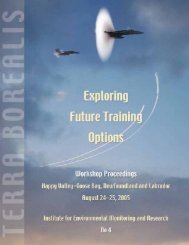2007 Annual Report - Institute for Environmental Monitoring and ...
2007 Annual Report - Institute for Environmental Monitoring and ...
2007 Annual Report - Institute for Environmental Monitoring and ...
- No tags were found...
You also want an ePaper? Increase the reach of your titles
YUMPU automatically turns print PDFs into web optimized ePapers that Google loves.
<strong>Institute</strong> <strong>for</strong> <strong>Environmental</strong> <strong>Monitoring</strong> <strong>and</strong> ResearchEleventh<strong>Annual</strong> <strong>Report</strong><strong>Institute</strong> <strong>for</strong> <strong>Environmental</strong><strong>Monitoring</strong> <strong>and</strong> ResearchQuananiche Brook<strong>2007</strong>
P a g e 4 I n s t i t u t e f o r E n v i r o n m e n t a l M o n i t o r i n g a n d R e s e a r c h 2 0 0 7 A n n u a l R e p o r tStatementfrom the ChairThis <strong>2007</strong> <strong>Annual</strong> <strong>Report</strong> represents the secondyear of operation <strong>for</strong> the <strong>Institute</strong> <strong>for</strong> <strong>Environmental</strong><strong>Monitoring</strong> <strong>and</strong> Research (IEMR) under the revisedMemor<strong>and</strong>um of Underst<strong>and</strong>ing (MOU) with theDepartment of National Defence (DND).To comply with the revised MOU, the <strong>Institute</strong> hasrevised many of its operational procedures. All<strong>Institute</strong> monitoring <strong>and</strong> research initiatives <strong>for</strong> <strong>2007</strong>were initiated following a public tendering process.The <strong>Institute</strong> specified the responsibility <strong>and</strong>deliverables <strong>for</strong> each contract, <strong>and</strong> the contractorswere responsible to ensure that all the necessarypermits <strong>and</strong> documents were obtained from theAboriginal, Provincial <strong>and</strong> Federal agencies.The <strong>Institute</strong> modified its data reporting procedureswith DND in order to comply with the operationalrequirements of 5 Wing Goose Bay. The <strong>Institute</strong><strong>and</strong> DND continue to review <strong>and</strong> adjust themonitoring priorities in order to enhance the viabilityof the revised training program while ensuring theconcerns of the Aboriginal people <strong>and</strong> the protectionof the natural environment are maintained.The members of the Scientific Review Committee(SRC) have continued to play a key role in ensuringthat credible science-based in<strong>for</strong>mation is collectedon noise disturbance associated with new trainingvenues <strong>and</strong> that appropriate mitigation measures areimplemented by DND. The SRC, along with itsassociated committees of technical experts, havebeen actively involved with the refinement of theBoomCast model which will assist in predictingsupersonic noise level thresholds at varying altitudes.The SRC <strong>and</strong> the technical committees continueto address the knowledge gaps associated with theeffects of noise disturbance from various militarytraining initiatives to ensure an appropriate level ofprotection, particularly <strong>for</strong> species that have beengranted special protection status, <strong>and</strong> also specieswhich are of particular concerns to the Aboriginalpeople.With the introduction of the Species at Risk Act(SARA) Legislation, the <strong>Institute</strong> has undertaken acomplete review of the valued ecosystem components(VECs) listing which was developed in thepreparation of the original <strong>Environmental</strong> ImpactStatement (EIS). In the course of its continueddiscussions with the Aboriginal communities, the<strong>Institute</strong> has initiated a comprehensive review of theVECs which may be impacted by noise associatedwith the military training program.The <strong>Institute</strong> continues to assist in facilitatingmeetings with DND <strong>and</strong> the Aboriginalrepresentatives to address issues of particularconcern to the Aboriginal communities.Through its publications <strong>and</strong> web site, the<strong>Institute</strong> provides an open <strong>for</strong>um where interestedindividuals can have access to the monitoring <strong>and</strong>effects research reports produced by the <strong>Institute</strong>.As future military training initiatives associated withGoose Bay continue to be defined, the <strong>Institute</strong> willneed to adjust its monitoring initiatives to ensurethat the wildlife populations are protected fromadverse noise disturbance. It is essential that the<strong>Institute</strong> continues to work in close collaborationwith DND <strong>and</strong> the provincial governments to ensurethat each training initiative proposed is evaluatedwithin an adaptive mitigation framework whichrespects the management responsibilities of both5 Wing Goose Bay <strong>and</strong> D Air CFG. This will ensurethat any new in<strong>for</strong>mation associated with the impactsof noise disturbance is integrated into the mitigationprogram in a timely fashion to ensure theprotection of the wildlife population <strong>and</strong> theviability of the military program.Louis LaPierre, Ph.D.<strong>Institute</strong> ChairDr. Louis LaPierre
Boardof DirectorsVoting Board MembersInnu NationMr. Richard NunaTown of Happy Valley – Goose BayMrs. Madelyn KellyNunatsiavut GovernmentMs. Marina Biasutti/ Mr. James GoudieCentral Labrador EconomicDevelopment Board, Inc.Mr. Geoff GoodyearMakivik Corporation*Mr. Stas OlpinskiMunicipalité régionale de comté de MinganieMr. Jacques L<strong>and</strong>ry /Mr. Richard NoëlLabrador Metis NationMs. Tammy LambourneChurchill Falls Town OfficeMr. Francis ClarkeMamit InnuatMr. Guy Bellefleur /Mr. András MákNaskapi Nation of Kawawachikamach*Mr. John Mameamskum*Rotational two-year basisNon-Voting Board MembersDepartment of National DefenceD AIR CFGCol J. D. GuérinDepartment of National Defence5 Wing Goose BayCol Mark Matheson/LCol Mark LeGresleyGovernment of Newfoundl<strong>and</strong> <strong>and</strong> LabradorMr. Ron BowlesGovernment of QuebecMr. Denis V<strong>and</strong>alEnvironment CanadaMr. Doug Bliss2 0 0 7 A n n u a l R e p o r t I n s t i t u t e f o r E n v i r o n m e n t a l M o n i t o r i n g a n d R e s e a r c h P a g e 5Mealy Mountains
P a g e 6 I n s t i t u t e f o r E n v i r o n m e n t a l M o n i t o r i n g a n d R e s e a r c h 2 0 0 7 A n n u a l R e p o r t<strong>Institute</strong> <strong>for</strong> <strong>Environmental</strong><strong>Monitoring</strong> <strong>and</strong> ResearchThe <strong>Institute</strong> was established in 1995 in responseto a recommendation by an independent<strong>Environmental</strong> Assessment Panel appointed to reviewmilitary flight training activities from the CanadianForces Base at Goose Bay. Its purpose is to overseethe environmental effects of Allied flight trainingconducted over areas of Labrador <strong>and</strong> northeasternQuebec. The <strong>Institute</strong> is governed by a Board ofDirectors representing Aboriginal <strong>and</strong> municipalgroups in the region with interests in militarytraining activities operated from 5 Wing Goose Bay.The Board has an independent Chair <strong>and</strong> non-votingmembers representing federal <strong>and</strong> provincialgovernments.The <strong>Institute</strong> has a primary interest in working with allparties affected by military training. It has developedan atmosphere of trust <strong>and</strong> respect amongst memberssharing different values <strong>and</strong> visions.The original MOU establishing the <strong>Institute</strong> expiredon March 31, 2006. A renewed grant agreement <strong>and</strong>MOU has since been signed with DND enabling the<strong>Institute</strong> to continue to operate <strong>and</strong> meet itsobjective as an independent research <strong>and</strong> monitoringbody until March 31, 2010. Prior to the expiration ofthe current MOU, the <strong>Institute</strong> <strong>and</strong> DND will assessthe current training activities <strong>and</strong> identify futureoptions <strong>for</strong> the <strong>Institute</strong>.MISSIONThe <strong>Institute</strong> is an independent arm’s lengthorganization from DND <strong>and</strong> reports to the Ministersof Environment <strong>and</strong> National Defence. It conductsscientific research <strong>and</strong> monitoring initiatives onthe Labrador <strong>and</strong> northeastern Quebec ecosystemswithin the Low-Level Training Area (LLTA) related tomilitary training activities. It also conducts researchon the socio-economic effects of these activities.The <strong>Institute</strong> will offer scientifically supportedrecommendations to the Ministers on the results ofthese studies should it conclude that the militarytraining does cause significant impacts that cannotbe effectively mitigated.MANDATEAs an independent advisory body to the Ministers ofEnvironment <strong>and</strong> National Defence, the <strong>Institute</strong>’sm<strong>and</strong>ate is to:• Focus on the protection of the environment <strong>and</strong>,within the concept of sustainable development,support the viability of the military flight-trainingprogram;• Provide independent verification of environmentaleffects as well as expertise <strong>and</strong> advice onstructuring adequate monitoring <strong>and</strong> mitigationmeasures; <strong>and</strong>• Foster a level of trust amongst all groups affectedby the military training program.In the event that studies show significant impacts areoccurring that cannot be mitigated or justified, the<strong>Institute</strong> may recommend that appropriate actionsbe taken to address the situation including makingrecommendation to the Ministers of Environment<strong>and</strong> National Defence that military flying activities belimited or phased out.OBJECTIVESIn order to carry out this m<strong>and</strong>ate, specific objectiveshave been identified:• Initiate, coordinate, support <strong>and</strong> conductenvironmental research;• Monitor effects <strong>and</strong> propose mitigation measuresassociated with the activities of military trainingover Labrador <strong>and</strong> northeastern Quebec;• Foster inclusion or incorporation of Aboriginalenvironmental knowledge <strong>and</strong> cooperation inresearch <strong>and</strong> monitoring activities amongst theDepartment of National Defence, scientificestablishments, research institutions, consultants,<strong>and</strong> universities interested in the m<strong>and</strong>ate <strong>and</strong>objectives of the <strong>Institute</strong>;• Promote a solid underst<strong>and</strong>ing <strong>and</strong> flow ofin<strong>for</strong>mation with the public on the work of the<strong>Institute</strong>.Hebron Church
OrganizationalChart* MakivikCorporation* Naskapi Nation ofKawawachikamachInnuNationLabrador MetisNationNunatsiavutGovernmentVoting Board MembersMamitInnuatTown of HappyValley-Goose BayMRC deMinganieChurchill FallsTown OfficeCentral LabradorEconomicDevelopment BoardBoard of DirectorsEnvironmentCanadaGovernment ofQuebecGovernment ofNewfoundl<strong>and</strong><strong>and</strong> LabradorNon-Voting Board MembersScientificReview CommitteeThe SRC consists of a group of recognized experts infields related to the types of impacts anticipated fromthe military flying program. They have been selected<strong>for</strong> their experience <strong>and</strong> knowledge on issues relatedto the northern ecosystem <strong>and</strong> its people. Membersof the SRC carry out the following roles:• Serve as a scientific advisory group to the Board;• Provide scientific direction <strong>and</strong> support <strong>for</strong> themonitoring <strong>and</strong> research activities approved by theBoard;• Establish the peer review process <strong>for</strong> all scientificpublications from the <strong>Institute</strong>;DNDD AIR CFGMinister of National DefenceMinister of EnvironmentDND5 Wing Goose BayDr. Louis LaPierreChairAdministrativeManagerSupport Staff*Rotational two-year basisMembers of the Scientific Review CommitteeChair:Members:Scientific ReviewCommitteeTechnicalCommittees• Ensure scientific accuracy <strong>and</strong> integrity, <strong>and</strong> definethe precise goals <strong>and</strong> objectives <strong>for</strong> all monitoring<strong>and</strong> research activities undertaken by the <strong>Institute</strong>;• Ensure the relevance of the proposed monitoring<strong>and</strong> research activities to the m<strong>and</strong>ate of the<strong>Institute</strong>;• Analyze <strong>and</strong> assess the results of the monitoring<strong>and</strong> research activities;• Advise the Board on the monitoring <strong>and</strong> researchpriorities.Dr. Louis LaPierre, Professor Emeritus, University of MonctonDr. Jean Huot, Retired, Laval UniversityMr. Gerry Parker, Retired, Canadian Wildlife ServicesDr. Fred Roots, Scientist Emeritus, Environment CanadaDr. David Schneider, Memorial University of Newfoundl<strong>and</strong>Mr. Bruce Turner, Retired, Canadian Wildlife Service2 0 0 7 A n n u a l R e p o r t I n s t i t u t e f o r E n v i r o n m e n t a l M o n i t o r i n g a n d R e s e a r c h P a g e 7
P a g e 8 I n s t i t u t e f o r E n v i r o n m e n t a l M o n i t o r i n g a n d R e s e a r c h 2 0 0 7 A n n u a l R e p o r t<strong>Institute</strong>PoliciesRESEARCH PRIORITIESThe Board of Directors is responsible <strong>for</strong> setting theresearch priorities <strong>for</strong> the <strong>Institute</strong> <strong>and</strong> ensures thatthe relevant criteria <strong>and</strong> policies are followed insoliciting contractors <strong>and</strong> awarding funding <strong>for</strong>research.In 2006, in keeping with the principles ofaccountability established by the federal government,a call <strong>for</strong> Statements of Interest was conducted toidentify companies interested in contractual workassociated with the <strong>Institute</strong>’s research agenda.To be eligible <strong>for</strong> consideration, companies had todemonstrate a proven track record associated withthe monitoring of noise disturbance on wildlife,provide proof of environmental liability insurance<strong>and</strong> be bondable. In <strong>2007</strong>, pre-qualified contractorswere given an opportunity to submit proposals toconduct research <strong>for</strong> the <strong>Institute</strong>.MEMORANDA OFUNDERSTANDINGThe <strong>Institute</strong> has Memor<strong>and</strong>a of Underst<strong>and</strong>ing withthe Department of National Defence, the Innu Nation,the Naskapi Nation of Kawawachikamach, thegovernment of Newfoundl<strong>and</strong> <strong>and</strong> Labrador, thegovernment of Quebec, <strong>and</strong> the Labrador InuitAssociation. These allow the <strong>Institute</strong> access to datasets in the possession of these organizations whilerecognizing their ownership of the in<strong>for</strong>mation.Berries on NWR RoadQuébec <strong>and</strong> Labrador communities <strong>and</strong>the low-level training areaResearchActivitiesThroughout <strong>2007</strong> the research agenda <strong>for</strong> the<strong>Institute</strong> was conducted on a contractual basis withcontinued support from DND, Aboriginal Nations <strong>and</strong>the governments of Quebec <strong>and</strong> Newfoundl<strong>and</strong> <strong>and</strong>Labrador. Contractors worked closely with the SRCto ensure the completion of several reports <strong>and</strong> thecontinuation of some multi-year studies.With limited military training in <strong>2007</strong>, the <strong>Institute</strong>has focused its monitoring <strong>and</strong> research initiativeson collecting basic ecological data on species whichcould be vulnerable to noise disturbance from highlevel military training. Considerable attention hasbeen allocated to the development of the BoomCastModel. Once validated, this predictive model willserve as an important tool in assessing noiseprojection from military training activities includingsupersonic <strong>and</strong> night training initiatives.In 2008, the <strong>Institute</strong> will define the monitoringprotocols <strong>for</strong> the VECs which have been identified aspotential c<strong>and</strong>idates <strong>for</strong> noise disturbance from theseproposed new training options.
<strong>Environmental</strong><strong>Monitoring</strong> <strong>and</strong> ResearchWOODLAND CARIBOUWoodl<strong>and</strong> caribou in Labrador <strong>and</strong> Quebec are listedas threatened under the SARA. This includes the RedWine Mountains Caribou Herd, the Lac JosephCaribou Herd, <strong>and</strong> caribou found in the Joir Riverarea of southern Labrador. The SRC have identifiedissues of concern with the distribution of woodl<strong>and</strong>caribou in the southern boundaries of the trainingarea associated with training block CYA 733.In <strong>2007</strong> under a service agreement with the <strong>Institute</strong>,the Wildlife Division of the government ofNewfoundl<strong>and</strong> <strong>and</strong> Labrador undertook populationsurveys/censuses of the sedentary Lac Joseph, RedWine, <strong>and</strong> Joir River caribou. The results, outlinedin reports filed with the <strong>Institute</strong>, focused on theproductivity <strong>and</strong> classification as well as the spatial<strong>and</strong> temporal distribution of woodl<strong>and</strong> animals.In anticipation of proposed new training initiatives,the SRC <strong>and</strong> Caribou Technical Committeedetermined that over time any new collardeployments or replacements associated withwoodl<strong>and</strong> caribou be GPS-satellite hybrid collars, asfine-scale GPS (global positional system) locationscan provide precise, remote, <strong>and</strong> nearly real-timecaribou locations. In <strong>2007</strong>, the <strong>Institute</strong> purchased23 of these new collars <strong>and</strong> plans are underway tohave these deployed during the 2008 field season.The data obtained from these collars will enablethe <strong>Institute</strong> to assess the movements of woodl<strong>and</strong>caribou within the southern portion of the trainingarea <strong>and</strong> will be used to assist 5 Wing Goose Bay todetermine appropriate mitigation measures.Happy ReunionStatus:• In 2008 any new collar deployment orreplacements on woodl<strong>and</strong> caribou will be withGPS-satellite hybrid collars.Red Wine Mountains Caribou Herd(RWMCH)Presently there are fourteen VHF (very highfrequency) collars <strong>and</strong> four satellite collars deployedon the RWMCH. Due to the high cost of aerialsurveys, the government of Newfoundl<strong>and</strong> <strong>and</strong>Labrador, in partnership with the <strong>Institute</strong>, haveagreed to replace all of the VHF collars withTelonics GPS-satellite hybrid models in 2008. Thesenew collars will provide a much greater accuracy <strong>for</strong>determining caribou locations on a regular four dayreporting cycle. In the event of the introduction ofnew training initiatives, they could be programmed<strong>for</strong> more frequent transmissions.Status:• In <strong>2007</strong> the government of Newfoundl<strong>and</strong> <strong>and</strong>Labrador conducted a survey of the RWMCH toreview the status of the existing VHF collars.• The <strong>Institute</strong>, in collaboration with thegovernment of Newfoundl<strong>and</strong> <strong>and</strong> Labrador, hasagreed to replace the existing VHF collars withGPS-satellite hybrid collars. These new collars willbe deployed during the winter of 2008.• The government of Newfoundl<strong>and</strong> <strong>and</strong> Labrador, incollaboration with the <strong>Institute</strong>, will conduct asecond late winter classification of the RWMCHearly in 2008.• The SRC will review the results from the fieldstudies <strong>and</strong> provide guidance to the <strong>Institute</strong> Board<strong>for</strong> future monitoring initiatives on the RWMCH.Joir River Caribou (JRC)There are currently eight satellite collars <strong>and</strong> fourGPS-satellite hybrid collars deployed on the JRC.The government of Newfoundl<strong>and</strong> <strong>and</strong> Labrador, inpartnership with the <strong>Institute</strong>, conducted adensity distribution <strong>and</strong> classification of theseanimals in <strong>2007</strong>. During these surveys, twocollars were replaced with GPS-satellite hybridcollars. The movements of these animals willcontinue to be examined to determine if they are infact part of a recognized herd or a separatepopulation. Early work indicates that they may beinteracting with members of the Mealy MountainCaribou Herd (MMCH) at certain times of the year.Current work conducted on the MMCH by thegovernment of Newfoundl<strong>and</strong> <strong>and</strong> Labrador providesa unique opportunity to compare the dynamics <strong>and</strong>movements of these two groups of caribou.2 0 0 7 A n n u a l R e p o r t I n s t i t u t e f o r E n v i r o n m e n t a l M o n i t o r i n g a n d R e s e a r c h P a g e 9
P a g e 1 0 I n s t i t u t e f o r E n v i r o n m e n t a l M o n i t o r i n g a n d R e s e a r c h 2 0 0 7 A n n u a l R e p o r tStatus:• The government of Newfoundl<strong>and</strong> <strong>and</strong> Labrador,in collaboration with the <strong>Institute</strong>, will conduct asecond late winter/early spring density, distribution<strong>and</strong> population estimate survey in 2008.• The <strong>Institute</strong> will consider installing additionalcollars on the Joir River animals following theanalysis of the field survey by the Wildlife Divisionof the government of Newfoundl<strong>and</strong> <strong>and</strong> Labrador.• The <strong>Institute</strong> continues to explore with theMinistère des Ressources naturelles et de la Faunedu Québec the feasibility of conducting a survey inthe Quebec portion of training block CYA 733 of themilitary training area (MTA) in 2008-2009.• The SRC will review the results from the fieldstudies <strong>and</strong> provide guidance to the <strong>Institute</strong>’sBoard <strong>for</strong> future monitoring initiatives on the JRC.Lac Joseph Caribou Herd (LJCH)There are eleven satellite collars <strong>and</strong> two VHF collarson the LJCH. The government of Newfoundl<strong>and</strong> <strong>and</strong>Labrador, in partnership with the <strong>Institute</strong>, willcontinue to collect <strong>and</strong> compile data collected by thesatellite collars currently deployed on this herd. The<strong>Institute</strong> is exploring with the Ministère desRessources naturelles et de la Faune du Québec thefeasibility of conducting a winter survey on theQuebec range of the LJCH in 2008-2009.Status:• The government of Newfoundl<strong>and</strong> <strong>and</strong> Labradorconducted a classification survey of the LJCH earlyin <strong>2007</strong>.• The <strong>Institute</strong>, in collaboration with the WildlifeDivision of the government of Newfoundl<strong>and</strong> <strong>and</strong>Labrador, will be replacing the current VHF <strong>and</strong>existing Argos collars with GPS-satellite hybridcollars as they reach the end of their reportingschedule.• The government of Newfoundl<strong>and</strong> <strong>and</strong> Labrador,in collaboration with the <strong>Institute</strong>, will conduct asecond late winter classification of the LJCH earlyin 2008.• The SRC will review the results from the fieldstudies <strong>and</strong> provide guidance to the <strong>Institute</strong>’sBoard <strong>for</strong> future monitoring initiatives on the LJCH.George River Caribou Herd(GRCH)As of March 31, 2006, with the expiration of the MOUwith the Allies, DND terminated its fundingagreement with the governments of Quebec <strong>and</strong>Newfoundl<strong>and</strong> <strong>and</strong> Labrador <strong>for</strong> continuedmonitoring of the GRCH. Following a review of thein<strong>for</strong>mation required, the <strong>Institute</strong> agreed to enterinto contractual arrangements with both governmentsto ensure a continuation of the monitoringinitiatives associated with the George River Herd.Status:• Given the reduction in military training <strong>and</strong> thetermination of funding by DND to the governmentsof Quebec <strong>and</strong> Newfoundl<strong>and</strong> <strong>and</strong> Labrador, the<strong>Institute</strong> conducted a feasibility analysis on thecontinued collection of data on the GRCH.• The <strong>Institute</strong> agreed to fund the cost of processingthe Argos data by CLS America to the governmentof Quebec <strong>for</strong> the duration of the current m<strong>and</strong>ateof the <strong>Institute</strong>. In return, the government ofQuebec provides data to the <strong>Institute</strong> fromtwenty-five Argos collars.• The government of Newfoundl<strong>and</strong> <strong>and</strong> Labrador iscurrently providing data to the <strong>Institute</strong> from fourcollars on the GRCH <strong>and</strong> are exploring thepossibility of providing the <strong>Institute</strong> with data fromten collars in 2008. The <strong>Institute</strong> has agreed toprovide funding to the government ofNewfoundl<strong>and</strong> <strong>and</strong> Labrador once they providedata <strong>for</strong> ten collars.• Following a review of the data, the SRC will providea recommendation on future data collection <strong>for</strong> theGRCH.• The <strong>Institute</strong> purchased three GPS-satellite hybridcollars, which were deployed on the GRCH by theWildlife Division of the government ofNewfoundl<strong>and</strong> <strong>and</strong> Labrador in <strong>2007</strong>.HABITAT DATABlack DuckThe need <strong>for</strong> relevant habitat data has been identifiedas a priority <strong>for</strong> many <strong>Institute</strong> sponsored projects.The <strong>Institute</strong> continues to acquire high-resolutionIkonos imagery datasets <strong>for</strong> portions of the LLTA.Due to extensive cloud coverage during the <strong>2007</strong>collection period, this dataset was not enhanced in<strong>2007</strong>. This order has been carried over <strong>for</strong> 2008 atwhich time the <strong>Institute</strong> plans to obtain Ikonosimagery <strong>for</strong> the core area of the RWMCH.Status:• The <strong>Institute</strong> will continue to acquire additionalIkonos imagery in 2008 to cover the range ofwoodl<strong>and</strong> caribou, particularly the RWMCH.
P a g e 1 2 I n s t i t u t e f o r E n v i r o n m e n t a l M o n i t o r i n g a n d R e s e a r c h 2 0 0 7 A n n u a l R e p o r tData CompilationThrough a cost sharing agreement between the WildlifeDivision of the government of Newfoundl<strong>and</strong> <strong>and</strong>Labrador <strong>and</strong> the <strong>Institute</strong>, a one year Data Coordinatorposition was advertised <strong>and</strong> filled in <strong>2007</strong>. As apartner, the Atlantic Canada Conservation Data Centrehas agreed to administer this position <strong>and</strong> providetechnical support. The focus of the small mammaldata compilation project is to compile all in<strong>for</strong>mation<strong>and</strong> data sources on small mammal studies completedin Newfoundl<strong>and</strong> <strong>and</strong> Labrador from 1960 to 2005.Small Mammal Trapping ProgramIn <strong>2007</strong> the <strong>Institute</strong> partnered with the governmentof Newfoundl<strong>and</strong> <strong>and</strong> Labrador, Innu Nation,Nunatsiavut government, <strong>and</strong> the Metis Nation to putin place a small mammal trapping program. In Junethe <strong>Institute</strong> hosted a training session to introducethe trapping protocol to ensure that data wascollected <strong>and</strong> comparable across all study sitesduring the fall trapping program. As a partner tothe program, the <strong>Institute</strong> conducted a trappingcampaign at Park Lake <strong>and</strong> Anne Marie Lake.A small mammal identification <strong>and</strong> databasingworkshop was held on the samples received. Thisjoint partnership program was very effective <strong>and</strong>there is agreement to continue this program on anannual basis.Status:• The <strong>Institute</strong> entered into a cost-sharing agreementwith the government of Newfoundl<strong>and</strong> <strong>and</strong>Labrador to conduct a data compilation survey onsmall mammal from 1960-2005.• The compiled data set will be housed at the AtlanticCanada Conservation Data Centre in Corner Brook.The data will provide a reference background <strong>for</strong>future small mammal studies in Newfoundl<strong>and</strong> <strong>and</strong>Labrador.• The results of the <strong>2007</strong> small mammal trappingprogram are currently being compiled <strong>and</strong> theresults will be published to the <strong>Institute</strong>’s web siteonce the analysis is completed.Snow mouseArctic Hare• The government of Newfoundl<strong>and</strong> <strong>and</strong> Labradorwill be responsible <strong>for</strong> the management <strong>and</strong> storageof all data <strong>and</strong> samples associated with the smallmammal monitoring network.• In 2008 the <strong>Institute</strong> will continue a small mammaltrapping program at two sites within the trainingarea as part of its contribution to the monitoringnetwork.• The <strong>Institute</strong> will continue to collaborate with thegovernment of Newfoundl<strong>and</strong> <strong>and</strong> Labrador todevelop a trapping protocol <strong>and</strong> training video to beused by all the participants in the network.• The <strong>Institute</strong> will continue to assist interestedAboriginal groups in setting up small mammalmonitoring networks within their communities byproviding the traps <strong>and</strong> co-sponsoring with thegovernment of Newfoundl<strong>and</strong> <strong>and</strong> Labrador atraining workshop on small mammal trapping.BARROW’S GOLDENEYEBarrow’s Goldeneye nest at high altitudes withinfishless lakes <strong>and</strong> there<strong>for</strong>e could be exposed to noisedisturbance associated with future militaryactivity, such as supersonic training. As thisspecies is presently considered as a species of specialconcern under the SARA, it is important that theappropriate mitigation measures are implemented.In<strong>for</strong>mation on the occurrence, distribution <strong>and</strong>abundance of this species is required be<strong>for</strong>eappropriate mitigation <strong>and</strong> avoidance measures canbe taken; there<strong>for</strong>e, in <strong>2007</strong> the <strong>Institute</strong> awarded acontract to LGL Limited <strong>for</strong> a preliminary assessmentof Barrow’s Goldeneye nesting within the proposedsupersonic training area CYA 732. The <strong>Institute</strong> isdeveloping a monitoring program in collaborationwith CWS to conduct a field survey within CYA 733<strong>for</strong> the 2008 field season.
Status:• The report “Barrow’s Goldeneye HabitatIdentification <strong>and</strong> Population Survey” was acceptedas presented <strong>and</strong> has been filed to the <strong>Institute</strong>’slibrary <strong>and</strong> web site.• In collaboration with CWS, the <strong>Institute</strong> willconduct a field study in 2008 to define the statusof the Barrow’s Goldeneye particularly in CYA 733.The objectives <strong>for</strong> this field study would be to:o Develop a field monitoring protocol <strong>for</strong> surveysto assess a sample of sites with high potential <strong>for</strong>breeding Barrow’s Goldeneye.o Undertake a field monitoring program to confirmthe occurrence or absence of breeding Barrow’sGoldeneye.GOLDEN EAGLESIn anticipation of supersonic training, a surveyprogram was initiated in the LLTA <strong>for</strong> Golden Eaglenests in 2005. The objective of this work was tore-examine previously known nests <strong>and</strong> to locate newnests <strong>and</strong> to assess their status <strong>and</strong> condition. Activenest sites were documented <strong>for</strong> consideration duringplanning of future monitoring studies <strong>for</strong> supersonictraining.In 2006, a monitoring program was conducted tocollect baseline observations of nesting Golden Eaglesin the absence of (prior to) noise <strong>and</strong> visualdisturbance associated with future training activities.Only one active nest was found <strong>and</strong> it was notdeemed suitable <strong>for</strong> observations. It is noted that thepoor nesting success may be related to the declinein small mammal populations in 2005, <strong>and</strong> thus thedecreased food supply that persisted into 2006. In<strong>2007</strong> the <strong>Institute</strong> awarded a contract to MinaskuatLtd. to conduct a survey within the LLTA. The studyteam visited fourteen Golden Eagle nests, of whichthree were found active. Given the currentdistribution of Golden Eagles in CYA 732 <strong>and</strong> theirlocation <strong>for</strong> observation, future effects monitoringwould need closer access <strong>and</strong> more sophisticatedobservation blinds <strong>for</strong> evaluating ‘subtle’ aspectsof nesting behaviour.Status:• The <strong>2007</strong> field study report “Baseline <strong>Monitoring</strong> ofGolden Eagle in the LLTA” has being reviewed bythe SRC <strong>and</strong> will be recommended <strong>for</strong> approval bythe Board in 2008.• Given the sensitivity associated with nest location,the geo-referencing data is filed at the <strong>Institute</strong>office.• The SRC is reviewing the feasibility of conductingGolden Eagle, Bald Eagle, <strong>and</strong> Osprey habitatidentification <strong>and</strong> monitoring program <strong>for</strong> the 2008field season.Picturesque ViewFIELD TESTING OFNEST MONITORSThe environmental effects monitoring related to thelow-level military aircraft training at 5 Wing GooseBay has addressed a variety of issues dealing withseveral species of avifauna. Conducted with supportfrom DND, studies have been directed at priorityspecies <strong>and</strong> have addressed parameters of interestaccording to their ability to be measured objectively<strong>and</strong> based on the biological significance of the effectbeing measured.The <strong>Institute</strong> has continued to work with thecompany TenXsys Inc. to develop an egg-shapedNestMonitor (“thermister”) in its ef<strong>for</strong>ts to continueto investigate the potential adverse effects of militarytraining. This device will help researchersdetermine if <strong>and</strong> <strong>for</strong> how long an adult remains off anest following a disturbance using changes inambient temperature as an indicator. Ambienttemperatures <strong>and</strong> noise exposures can be measureddirectly from the nest with accuracy verified by fieldobservations. The use of NestMonitors would obviatethe need <strong>for</strong> visual observations, thereby reducingbiases induced by researcher disturbances. TheNestMonitors are capable of measuring decibel levels<strong>and</strong> nest temperature (at the surface of the ‘egg’) <strong>and</strong>will also be equipped with a VHF signal to facilitaterelocation should the nest be raided by a predator.In 2006 the <strong>Institute</strong> contracted the services of theconsulting company Minaskuat Ltd. to field test theNestMonitors on Canada Geese, Bald Eagle <strong>and</strong>Osprey. As this technology was highly experimental,it was proposed to test the NestMonitors incombination with visual observations. During theinitial program, technical problems were reported<strong>and</strong> in March <strong>2007</strong> a workshop was arranged withTenXsys Inc. to address these concerns.2 0 0 7 A n n u a l R e p o r t I n s t i t u t e f o r E n v i r o n m e n t a l M o n i t o r i n g a n d R e s e a r c h P a g e 1 3
P a g e 1 4 I n s t i t u t e f o r E n v i r o n m e n t a l M o n i t o r i n g a n d R e s e a r c h 2 0 0 7 A n n u a l R e p o r tIn follow up, in <strong>2007</strong> a revised field program wasconducted by Minaskuat Ltd. using nesting BaldEagle, Osprey, <strong>and</strong> Canada Goose. The technologicalcapabilities of the NestMonitors to record both noise<strong>and</strong> temperature at the surface of this device weredemonstrated; however, they could not differentiatebetween proximal <strong>and</strong> distal noise events. Finalreports <strong>for</strong> these programs have been reviewed bythe SRC <strong>and</strong> accepted by the <strong>Institute</strong>’s Board.Additionally, in <strong>2007</strong> the <strong>Institute</strong> issued a RFP towork with five Canada Goose nests near the GooseBay Airport to compare the influence of adultbehaviour on noise signature <strong>and</strong> temperaturelevels. This work was completed under contract byMinaskuat Ltd. <strong>and</strong> a final report has been filed withthe <strong>Institute</strong>.The opportunities <strong>for</strong> the use of this technology <strong>for</strong>similar studies related to the potential effects ofmilitary training on the environment are extensive.The challenge will be to ensure the experiment isdesigned in such a manner as to isolate theparameters of interest in the sensors of theNestMonitors. The longevity of the battery, extensivestorage capacity <strong>and</strong> ease of transport, deployment<strong>and</strong> retrieval suggest additional applications <strong>for</strong> the<strong>Institute</strong>.Status:• The SRC <strong>and</strong> technical experts met in March <strong>2007</strong>with representatives of TenXsys to discuss theresults of the 2006 field testing of the NestMonitors. They agreed that the nest monitors canserve a useful function in future noise monitoringinitiatives; however, their use must be carefullydefined in order to ensure that the appropriatenoise events are captured <strong>and</strong> recorded.• The 2006-<strong>2007</strong> report “Field Testing of NestMonitors – Bald Eagle <strong>and</strong> Osprey Component” hasbeen filed to the <strong>Institute</strong>’s library <strong>and</strong> web site.• The 2006-<strong>2007</strong> report “Field Testing of NestMonitors – Canada Goose Component” has beenfiled to the <strong>Institute</strong>’s library <strong>and</strong> web site.• The <strong>2007</strong> report “Field Testing of Nest Monitors– Canada Goose Component” has been filed withthe <strong>Institute</strong> <strong>and</strong> reviewed <strong>and</strong> accepted by theSRC. It will be reviewed by the Board in 2008.• The <strong>Institute</strong> will not conduct any further testing ofthe noise monitors until they have an indication ofthe level of military training.• The <strong>Institute</strong> will deploy NestMonitors in the fieldduring any night time training initiative which maytake place in 2008.ASSESSMENT OFSUPERSONIC TEST FLIGHTSOver the past three years, DND has undertaken toprepare an environmental assessment (EA) to besubmitted to the government of Newfoundl<strong>and</strong> <strong>and</strong>Labrador to conduct supersonic flight training at the5 Wing Goose Bay Air Ranges. This is in responseto a need to exp<strong>and</strong> the previous training activities<strong>and</strong> to meet changing operational requirements of air<strong>for</strong>ces from <strong>for</strong>eign nations.It was evident from the literature reviews conductedin recent years that in<strong>for</strong>mation is not readilyavailable <strong>for</strong> all of the species that may be impactedby supersonic training. It has been recommended bythe SRC that the noise disturbances <strong>and</strong> overpressuresgenerated by supersonic training must bemitigated, particularly if the floor training level is setat 5,000 feet above ground level. A mitigationprogram based on the existing data may seemeffective now; however, as more data is collectedon the impacts of supersonic booms, the mitigationprogram may require alterations to be truly effective.Over the past two years, the SRC have spentconsiderable time working with the technicalexpertise of Dr. Kenneth Plotkin from Wyle Labs <strong>and</strong>RWDI Air in developing the BoomCast Model. Thispredictive model incorporates PC Boom <strong>and</strong> BooMapto determine noise disturbance thresholds on VECsacross the l<strong>and</strong>scape. The purpose of this work isto assist in determining, from a meteorological orclimatological perspective, what times of year are lessrestrictive <strong>for</strong> supersonic training activities over theCYA 732 training airspace. In <strong>2007</strong> two workshopswere held to assist the SRC in identifying the VECswhich should be considered in future monitoringinitiatives. Following the compilation of the resultsof these workshops along with the collation ofin<strong>for</strong>mation which was provided by the Aboriginalcommunities, the SRC will reconvene a smallcommittee of expertise to assist them with thedevelopment of a risk assessment threshold <strong>for</strong> eachimportant VEC to determine what would constitutean acceptable noise disturbance level.Status:• Given the current knowledge on the effects ofmilitary training on wildlife, an adaptivemanagement approach should be an integralcomponent in developing a monitoring <strong>and</strong>mitigation program.• In May 2008, the SRC <strong>and</strong> a panel of expertise willconduct a risk assessment <strong>for</strong> the VECs that couldbe impacted by future military training initiatives.• The BoomCast model is currently being beta tested,<strong>and</strong> the <strong>Institute</strong> will conduct field testing as soonas a training scenario is defined by DND.• In 2008 a demonstration of the model will bepresented to the <strong>Institute</strong>’s Board.Waterfowl
Economic<strong>Monitoring</strong> <strong>and</strong> ResearchECONOMIC IMPACT STUDYPreviously, the <strong>Institute</strong> completed three reportsassociated with the economic impact of military flighttraining in Labrador <strong>and</strong> Northeastern Quebec.These studies qualitatively <strong>and</strong> quantitativelyassessed the economic impacts of military flighttraining <strong>for</strong> this region. The last of these reportsconcluded that the study area has recovered fromthe psychological <strong>and</strong> economic shock that itexperienced as a result of downsizing <strong>and</strong>alternative service delivery, but it is now about toenter a new period of readjustment with thedeparture of the Allies.LobstickIn 2006 the Economic Committee <strong>and</strong> DND revieweda study proposal submitted by the consulting firmAMEC. There was agreement that a two-part studybe undertaken. Firstly, an economic survey wasconducted on a select number of industries <strong>and</strong>businesses in Goose Bay in the late fall of 2006. Thesecond phase of the study was completed in <strong>2007</strong>with the objective to conduct a detailed economicimpact analysis of the economic activities directlyattributable to 5 Wing Goose Bay <strong>for</strong> the fiscal year2006-<strong>2007</strong>.Status:• A final report incorporating the results of theeconomic survey <strong>and</strong> the results from the input/output model has been received by the <strong>Institute</strong><strong>and</strong> is currently being reviewed by the SRC <strong>and</strong>the Economic Committee. Once the review iscompleted, the SRC will recommend futureinitiatives to the <strong>Institute</strong>’s Board.Fireweed at Voisey’s Bay2 0 0 7 A n n u a l R e p o r t I n s t i t u t e f o r E n v i r o n m e n t a l M o n i t o r i n g a n d R e s e a r c h P a g e 1 5Partridge
P a g e 1 6 I n s t i t u t e f o r E n v i r o n m e n t a l M o n i t o r i n g a n d R e s e a r c h 2 0 0 7 A n n u a l R e p o r tCommunicationsMaintaining a sound communication strategy is avital role of the <strong>Institute</strong>. Communicationactivities foster a level of trust amongst all groupsaffected by the military training program.In<strong>for</strong>mation on <strong>Institute</strong> projects, activities <strong>and</strong>research is freely available to the public through theweb site (www.iemr.org) <strong>and</strong>, on request, from theoffice.FIRST NATIONSCOMMUNICATION ANDSUPPORT STRATEGYIn 1998 the First Nations Communication <strong>and</strong> SupportStrategy was established to provide a communicationlink between the Aboriginal communities affectedby the low-level flying program, the <strong>Institute</strong>’sresearchers, members of the SRC <strong>and</strong> non-Aboriginalmembers of the Board of Directors. In each community,the Liaison Officer met with committees ofAboriginal Experts recognized <strong>for</strong> their knowledge ofthe territory <strong>and</strong> its wildlife. The primary goal of theprogram was to in<strong>for</strong>m the Expert Committees of the<strong>Institute</strong>’s work <strong>and</strong> to communicate an underst<strong>and</strong>ingof their concerns to the SRC <strong>and</strong> the <strong>Institute</strong>’sBoard of Directors. In 2005, a final round of visitsunder this program was conducted to thank themembers of the Expert Committees <strong>for</strong> their valuablecooperation, to provide an update on <strong>Institute</strong>sponsoredresearch projects, to review the future<strong>for</strong> the <strong>Institute</strong> <strong>and</strong> to obtain comments from theAboriginal experts on how they felt about thecommunication program. A final report on thesevisits has been filed with the <strong>Institute</strong>.Morning ReflectionIn <strong>2007</strong> the Chair met with the representatives of theAboriginal communities to assess the options whichcould be initiated by the <strong>Institute</strong> to support the FirstNations Communication <strong>and</strong> Support Strategy. Giventhat the military training options <strong>for</strong> Goose Bay arenot clearly defined, it was agreed that an interimprogram would focus on activities associated with theidentification of the important VECs <strong>and</strong> thepresentation of the EA <strong>for</strong> supersonic flight training.These community consultations were defined by theAboriginal Board members <strong>and</strong> funded by <strong>Institute</strong>.Status:• The <strong>Institute</strong> has developed with thecollaboration of the Aboriginal Board members aninterim communication <strong>and</strong> in<strong>for</strong>mation strategy<strong>for</strong> the coming year which will focus on the reviewof the EA associated with the proposed supersonictraining program.CONFERENCESSince 1997, the <strong>Institute</strong> has sponsored fourworkshops/conferences. Proceedings <strong>for</strong> thefollowing can be made available through the officeor at www.iemr.org in editions of Terra Borealis.• Traditional <strong>and</strong> Western Scientific<strong>Environmental</strong> Knowledge• Effects of Noise on Wildlife• Waterfowl• Exploring Future Training Options
Northern WaterthrushIn September 2006, many <strong>Institute</strong> Board membersattended the Night Strike 2006 - Freedom of FlightAerospace Conference <strong>and</strong> Exhibition held at 5 WingGoose Bay. This provided an excellent opportunity<strong>for</strong> members to build on their knowledge of nightoperations. In addition to a range of topics on therole of Goose Bay in the international aerospaceenvironment, a dedicated conference sessionhighlighted community diversification.In November <strong>2007</strong>, the <strong>Institute</strong> Board membersattended the UVS Canada “Exp<strong>and</strong>ing Horizons”conference in St. John’s, Newfoundl<strong>and</strong> <strong>and</strong>Labrador. This unique conference addressed issuessurrounding airspace access, technical st<strong>and</strong>ards,international cooperation, defence <strong>and</strong> security <strong>and</strong>the latest results from cutting-edge research <strong>and</strong>development.At the 154th Meeting of the Acoustical Society ofAmerica Conference held in New Orleans,Louisiana, in November <strong>2007</strong>, Dr. Kenneth Plotkinmade a presentation on the “<strong>Monitoring</strong>, Predication<strong>and</strong> Management of Sonic Booms in a ValuedEcosystem”. This work was co-authored by Dr. LouisLapierre, Chair of the <strong>Institute</strong>, <strong>and</strong> Mr. WayneBoulton of RWDI Air.In November 2008, the <strong>Institute</strong> will be acollaborating partner with the government ofNewfoundl<strong>and</strong> <strong>and</strong> Labrador as they host the 12thNorth American Caribou Workshop in HappyValley-Goose Bay. The theme of this workshop is“Integrating Underst<strong>and</strong>ing Across Ecotypes”.INSTITUTE PUBLICATIONSAll <strong>Institute</strong> publications are available in French<strong>and</strong> English <strong>and</strong> can be obtained either through theweb site or by contacting the main office. Thesepublications include conference proceedingspublished in editions of Terra Borealis <strong>and</strong> annualreports.WEB SITE (www.iemr.org)The <strong>Institute</strong>’s easily navigated web site providesaccess to what’s new at the <strong>Institute</strong>, includingupdates on events <strong>and</strong> research activities, severallibrary databases <strong>and</strong> photo galleries. Visitors areinvited to register with an e-mail database to benotified of updates as they occur.Pretty PoserPHOTO CONTESTThe 7th <strong>Annual</strong> IEMR Photo Contest proved to bevery successful in <strong>2007</strong> with 43 entries. Photos hadto be of wildlife, wildlife habitat or l<strong>and</strong>scapes <strong>and</strong>had to be taken within the Quebec-LabradorPeninsula. All entries were posted to the <strong>Institute</strong>’sweb site, <strong>and</strong> visitors to the site were invited to vote<strong>for</strong> their favourite photo. Some of the entriesreceived are printed throughout this annual report<strong>and</strong> the winning photo graces its cover. The photosused throughout this report reflect the work of thoselisted on its inside cover <strong>and</strong> includeentries from Board members,government employees, researchers<strong>and</strong> members of the general public.2 0 0 7 A n n u a l R e p o r t I n s t i t u t e f o r E n v i r o n m e n t a l M o n i t o r i n g a n d R e s e a r c h P a g e 1 7Hebron Bay
P a g e 1 8 I n s t i t u t e f o r E n v i r o n m e n t a l M o n i t o r i n g a n d R e s e a r c h 2 0 0 7 A n n u a l R e p o r tProject Component Issues11. The panel recommended that thelocation of a second practice targetarea be assessed by the <strong>Institute</strong> be<strong>for</strong>eNewfoundl<strong>and</strong> <strong>and</strong> Labrador governmentapproval of the site is requested.Appendix A:Follow-Up on Panel Recommendations <strong>and</strong> Government DecisionsPANEL RECOMMENDATIONS GOVERNMENT DECISIONS INSTITUTE RESPONSESocial Impacts22. The panel recommended that the<strong>Institute</strong> undertake studies to determinethe extent of resource harvesting activityon the l<strong>and</strong> <strong>and</strong> the impact that low-levelflying might have on Aboriginal <strong>and</strong>non-Aboriginal resource harvesting.Health Impacts25. The panel recommended that studiesof hydrocarbon concentrations in fueldumping areas include the behaviourof petroleum hydrocarbons in aquaticsystems.Labrador OutportThe Government accepted thisrecommendation <strong>and</strong> it wasreferred to the <strong>Institute</strong>.Government accepted thisrecommendation <strong>and</strong> referred itto the <strong>Institute</strong>.Government accepted thisrecommendation with anexplanatory comment. “TheDepartment of National Defencewill continue its current workon hydrocarbon concentrationsin fuel dumping areas <strong>and</strong> willrefer the research on thebehaviour of petroleumhydrocarbons in aquaticsystems to the <strong>Institute</strong>”.In the event that DND confirms a requirement <strong>for</strong> areconfigured or a second PTA at a future date, the<strong>Institute</strong> will undertake an assessment <strong>and</strong> present itsrecommendations to the appropriate authorities.In 2006, the IEMR collated background in<strong>for</strong>mationwhich could be used to assess the location of futuresites.There were no additional discussions on the locationof additional practice sites in <strong>2007</strong>.The IEMR <strong>and</strong> the Western Newfoundl<strong>and</strong> ModelForest have agreed to:a) Continue a cost-sharing program to purchaseIkonos data <strong>for</strong> the LLTA.b) Partner with the Innu Nation to develop a <strong>for</strong>estbasedhabitat analysis of the <strong>for</strong>ested l<strong>and</strong>s withinthe LLTA.c) Explore the possibilities of sharing the Ikonos datawith the Innu Nation. This aspect will focus on theidentification of critical caribou habitat.d) Explore future funding arrangements to identify theimpact of logging on critical caribou habitat.The IEMR continues to partner with Canadian ForestService with the development of a revised <strong>for</strong>estclassification using the IKONOS data purchased byIEMR.The IEMR will continue to purchase additional IKONOSdata in the coming year in order to support theclassification of the RWMCH.The IEMR has requested that DND provide an annualreport on the frequency <strong>and</strong> location of major fueldumps. This report should include the volume of fueljettisoned.The IEMR has requested that DND provide anup-to-date digital map set of all fuel dumps. Thisdigital data should be made available <strong>for</strong> review bythe Aboriginal <strong>and</strong> non-Aboriginal communities.The IEMR has collaborated with the LabradorContaminants Working Group <strong>for</strong> the completion of acontaminants database <strong>for</strong> Labrador which isaccessible at www.lcwg.ca.The IEMR did not support any initiatives regardinghydrocarbon concentration during <strong>2007</strong>.
PANEL RECOMMENDATIONS GOVERNMENT DECISIONS INSTITUTE RESPONSE27. The panel recommended that acontinuing program of monitoring <strong>and</strong>study be carried out to ensure that noiseeffects do not remain undiscovered <strong>and</strong>unmitigated. Particular attention should bepaid to monitoring the impact of noise onthe school environment.Natural Environment Issues30. The panel recommended that astudy to determine the behavioural <strong>and</strong>population responses of Osprey <strong>and</strong>Bald Eagles to overflights be an effectsmonitoring priority.Neat St<strong>and</strong>Government accepted thisrecommendation <strong>and</strong> it wasreferred to the <strong>Institute</strong>.Government accepted thisrecommendation <strong>and</strong> it is to beimplemented as appropriate,following consultation withprovincial authorities, the<strong>Institute</strong>, stakeholders or otheragencies.Previous studies reviewed by the IEMR indicated thatthe current noise disturbance within Spruce Park <strong>and</strong>the surrounding areas comply with the acceptableCanadian guidelines. Robert Leckie School, which waslocated in Spruce Park, has been closed since 1998.Should supersonic training take place, the IEMRwill undertake a field monitoring program. Noisedisturbance around the aerodrome will be monitoredduring the evening segments of this training initiativeto ensure that noise levels do not cause unduedisturbances. Particular attention would be allocatedto noise disturbance within Spruce Park shouldtraining occur during the evenings.Should military transport aircraft (transall) trainingbecome an important component of the trainingactivities, the IEMR will assess the noise disturbanceassociated with it within the LLTA.The IEMR has finalized a working version of Boom-Cast. The predictive model is currently being betatested by the IEMR. Following the initial verification,IEMR will proceed with a field testing of the model.After a review of the results of four years ofmonitoring of Osprey populations conducted by DND,the IEMR agreed to continue a long-term monitoringprogram of Osprey population trends <strong>and</strong> reproductionsuccess within <strong>and</strong> outside the LLTA. This monitoringprogram identified any sudden changes within theOsprey population <strong>and</strong> also provided additional datathat could help to assess the residual impacts thatcould not be confirmed from the previous DNDstudies.In <strong>2007</strong>, the IEMR finalized the fifth year of itslong-term monitoring program of Osprey populationtrends <strong>and</strong> reproductive success both within <strong>and</strong>outside the LLTA. The results indicate that annualvariances do occur in the populations located within<strong>and</strong> outside the LLTA. However, the results to date donot indicate any significant long-lasting trends.The IEMR will proceed with the analysis of the Ospreydata collected. Following the analysis, IEMR willreconvene a technical workshop to assess the resultsof the analysis <strong>and</strong> determine if future field monitoringis required.2 0 0 7 A n n u a l R e p o r t I n s t i t u t e f o r E n v i r o n m e n t a l M o n i t o r i n g a n d R e s e a r c h P a g e 1 9
P a g e 2 0 I n s t i t u t e f o r E n v i r o n m e n t a l M o n i t o r i n g a n d R e s e a r c h 2 0 0 7 A n n u a l R e p o r tPANEL RECOMMENDATIONS GOVERNMENT DECISIONS INSTITUTE RESPONSE31. The panel recommended thatthe important breeding, moulting<strong>and</strong> staging concentrations ofwaterfowl in the unsurveyed areascovered by Option “B” be givenpriority.Shoal Point Inukshuk32. The panel recommended thatthe <strong>Institute</strong> consider whether theidentification of potential nestinghabitat of Harlequin Ducks needs tobe undertaken <strong>and</strong> if it can beaccomplished as an add-on to otherfield studies (e.g. river valley study).Terrington BassinGovernment accepted thisrecommendation.Government acceptedthis recommendation <strong>and</strong>referred it to the <strong>Institute</strong>.Following a review of the Moulting Black Duck Study, the SRC<strong>and</strong> Waterfowl Technical Committee members recommendedthat the IEMR not continue this project. Should field monitoringdata indicate a need <strong>for</strong> additional in<strong>for</strong>mation, the project couldbe reviewed.The IEMR will review the results of the spring staging waterfowlstudy.In 2005, in collaboration with DND <strong>and</strong> CWS, the IEMRconcluded a second year of field investigation on the impacts ofmilitary aircraft on nesting Canada Geese. The results indicatethat Canada Geese do demonstrate a strong behaviouralresponse to military jets, helicopters <strong>and</strong> fixed-wing aircraft;however, the results do not indicate any significant long-termpopulation impact.Egg shaped nest monitors were integrated into the 2006 <strong>and</strong><strong>2007</strong> field program to measure noise dosage <strong>and</strong> temperaturesat the nest during incubation. Upon review of the results, theIEMR recommend that although the nest monitors can serve auseful function in future noise monitoring initiatives, their usemust be carefully defined in order to ensure that the appropriatenoise events are captured <strong>and</strong> recorded. The IEMR will notconduct any further testing of the noise monitors until they havean indication of the level of military training.The IEMR is continuing an analysis of waterfowl habitat usingIkonos satellite imagery.In anticipation of the introduction of military supersonic flights,the IEMR has initiated a study on the Barrow’s Goldeneye. Thisspecies nests at high altitudes within fishless lakes, <strong>and</strong> theycould be vulnerable to noise disturbance. As this species ispresently listed as a species of special concern under the SARA,it is important that the appropriate mitigation measures areimplemented.The IEMR completed a preliminary survey on the distribution ofbreeding Barrow’s Goldeneye within training block 732 of theMTA during the <strong>2007</strong> field season.In 2008 in collaboration with CWS, the IEMR will conduct asurvey within training block 733 of the LLTA. Following thissurvey an assessment will be conducted to determine if futureassessment is required.In 2004 the IEMR reviewed the results of the four years ofstudies conducted on Harlequin Duck. Following this, in consultationwith the CWS <strong>and</strong> DND, it was agreed that the closures onHarlequin Duck would be lifted within the LLTA. As a condition, athree year population trend survey was to be conducted.Surveys were conducted in 2005 <strong>and</strong> 2006 by the CWS <strong>and</strong> thepreliminary results have been reviewed by the SRC. A decisionto have four years of monitoring conducted over a five yearperiod has been made.A population trend survey <strong>for</strong> Harlequin Duck was not conductedin <strong>2007</strong>. A RFP was developed to conduct a two year studyin 2008 <strong>and</strong> 2009, <strong>and</strong> a contract has been awarded to LGLLimited.The IEMR will assess the results of the four field seasons todetermine what future monitoring may be needed to ensure thatHarlequin Duck populations are not unduly disturbed by militarytraining activities.Following a review of the analysis, the SRC will recommend tothe <strong>Institute</strong>’s Board what additional studies may be required.
PANEL RECOMMENDATIONS GOVERNMENT DECISIONS INSTITUTE RESPONSE33. The panel recommended that,depending on the in<strong>for</strong>mation generated bybaseline studies in the new flight trainingconfiguration <strong>and</strong> armed with knowledgeof how many of the 1400 proposed nightsorties are low-level, the <strong>Institute</strong>determine if the impact of night sortiesneeds to be monitored.34. The panel recommended that prioritybe given to studies aimed at describingriver valley resources <strong>and</strong> monitoringprograms to evaluate impacts of theProject <strong>and</strong> wildlife resources in them.36. The panel recommended that a studybe undertaken to determine the locationsof winter moose concentrations in theOption “B” configuration be<strong>for</strong>e the area isreleased <strong>for</strong> flight training.MooseGovernment accepted thisrecommendation <strong>and</strong> referred itto the <strong>Institute</strong>.Government accepted thisrecommendation <strong>and</strong> referred itto the <strong>Institute</strong>.Government accepted thisrecommendation <strong>and</strong> it is to beimplemented as appropriate,following consultation withprovincial authorities, the<strong>Institute</strong>, stakeholders <strong>and</strong> otheragencies.The SRC has reviewed the preliminary results of theBoreal Owl Study <strong>and</strong> has agreed to terminate theproject. The results from the field study havedemonstrated that Boreal Owls could serve as anappropriate surrogate <strong>for</strong> a noise disturbance study;however, due to the limited number of subsonicflights, it was agreed that future field initiatives shouldbe phased into the supersonic initiatives.The IEMR has completed the review of the two fieldstudies that were conducted on nocturnal species<strong>and</strong>, from the data obtained they did not confirm anymajor impact on the species studied.The IEMR had planned to conduct nocturnal fieldsurveillance during the night strike exercises in <strong>2007</strong>.This exercise was cancelled.The IEMR will conduct nocturnal field surveillanceduring future night training sessions which may beplanned <strong>for</strong> the 2008 field season. The monitoringinitiatives will focus on waterfowl, raptors, owls <strong>and</strong>bats.The IEMR has completed studies on Gray Jays <strong>and</strong>Boreal Owls; both species are known as river valleydwelling species. However, with the reduction ofsubsonic flights within the LLTA, the need to focuson river dwelling species is not considered a priority.The nature of supersonic training will not require afocused use of river valleys as priority pathways.The IEMR has completed the studies of Boreal Owls<strong>and</strong> bats. Following a review of the future trainingrequirements, the IEMR will assess the need <strong>for</strong> anyadditional studies.The IEMR will include monitoring initiatives associatedwith river valley ecosystem related species during thefuture training program initiatives.The IEMR has collected data on moose distributionduring its field sampling of caribou at both the LacJoseph <strong>and</strong> Red Wine areas. A report was filed as aninterim report to the IEMR. The results did not warrantany further assessment at that time.The IEMR has initiated a RFP which will assess themoose distribution within the MTA. The field study willtake place in 2008. Following the completion of thefield study, the SRC will review the data <strong>and</strong> assess ifadditional changes are required to the currentmitigation program.2 0 0 7 A n n u a l R e p o r t I n s t i t u t e f o r E n v i r o n m e n t a l M o n i t o r i n g a n d R e s e a r c h P a g e 2 1
P a g e 2 2 I n s t i t u t e f o r E n v i r o n m e n t a l M o n i t o r i n g a n d R e s e a r c h 2 0 0 7 A n n u a l R e p o r tPANEL RECOMMENDATIONS GOVERNMENT DECISIONS INSTITUTE RESPONSE37. The panel recommended that, in viewof the increased number of sorties, foodchain monitoring studies be carried out.Mouth of the RiverCaribou38. The panel recommended acontinuation of the Red Wine caribou calfsurvival study.Caribou39. As a precautionary measure, the panelrecommended that the seasonaldistribution of the Lac Joseph Herd beestablished prior to the commencement offlying in the reconfigured training area todetermine if adjustments should be madeto the training area’s western boundary.Government acceptedthis recommendation <strong>and</strong>referred it to the <strong>Institute</strong>.Government acceptedthis recommendation <strong>and</strong>referred it to the <strong>Institute</strong>.Government accepted thisrecommendation <strong>and</strong> it is to beimplemented as appropriate,following consultation withprovincial authorities, the<strong>Institute</strong>, stakeholders or otheragencies.The IEMR has completed a two-year study on GrayJays. The study was conducted at the end of the GooseBay airport runway. There was a wide variety of noisedisturbance along with a statistically valid populationof Gray Jays. The results from the study indicated thatthere was no significant difference in the behaviour ofGray Jay populations at the end of the runway <strong>and</strong> at thecontrol site.The IEMR completed a study of Boreal Owl <strong>and</strong> its preyspecies. The results of the study indicate that BorealOwl productivity is closely linked with the abundanceof small mammals. No significant impact from thelow-level training program can be attributed to changeswithin the natural cycles of small mammals.The IEMR will review the need <strong>for</strong> additional studies oncethe future training requirements are clearly defined.The IEMR is reviewing the status of the RWMCH followingthe designation of woodl<strong>and</strong> caribou as endangered.Noise monitoring collars have been purchased by theIEMR <strong>and</strong> DND, which will facilitate the underst<strong>and</strong>ing ofnoise disturbance on the RWMCH.The IEMR will work with the government ofNewfoundl<strong>and</strong> <strong>and</strong> Labrador to identify <strong>and</strong> implementan effective noise monitoring program in the next year.The Wildlife Division of the government of Newfoundl<strong>and</strong><strong>and</strong> Labrador completed a population assessment of theRWMCH during the winter of <strong>2007</strong>.The IEMR in collaboration with the Wildlife Division ofthe government of Newfoundl<strong>and</strong> <strong>and</strong> Labrador willconduct a second population assessment of the RWMCHduring the winter of 2008. The results of the survey willbe reviewed by the SRC <strong>and</strong> recommendations will bereviewed by the IEMR <strong>for</strong> future monitoring <strong>and</strong>assessments.The IEMR has purchased a series of satellite hybridcollars to replace the VHF collars which are currentlydeployed on the woodl<strong>and</strong> caribou herds. Thedeployment of the collars will take place during thewinter <strong>and</strong> spring of 2008 in collaboration with theWildlife Division of the government of Newfoundl<strong>and</strong> <strong>and</strong>Labrador.The IEMR in collaboration with the governments ofQuebec <strong>and</strong> Newfoundl<strong>and</strong> <strong>and</strong> Labrador will assessthe feasibility of initiating a noise collar monitoringprogram on the LJCH.The Wildlife Division of the government of Newfoundl<strong>and</strong><strong>and</strong> Labrador conducted a survey <strong>and</strong> assessedthe population structure of the LJCH during the <strong>2007</strong>winter field season.The IEMR will continue discussions with the governmentof Quebec on the possibility of a future jointassessment of the movement of the herd betweenQuebec <strong>and</strong> Newfoundl<strong>and</strong> <strong>and</strong> Labrador. The IEMRwill also deploy some new collars on the LJCH.
PANEL RECOMMENDATIONS GOVERNMENT DECISIONS INSTITUTE RESPONSEMitigation <strong>and</strong> Avoidance41. The panel recommended that the<strong>Institute</strong> examine the success of the“in-town” mitigative measuresproposed in the EIS <strong>and</strong> suggestmodifications to these measurementsas required in the future.42. Until adequate baseline studieshave been completed in the new areasto be over flown, the panelrecommended that flying continue tobe conducted in the present low-leveltraining areas with no reduction at thistime in current avoidance criteria.48. The panel recommended thatin<strong>for</strong>mation be transmitted to the publicon the work being done by the <strong>Institute</strong>,the changes to the avoidance program<strong>and</strong> results of research <strong>and</strong> complianceauditing.49. The panel recommended thatcompliance monitoring be conductedby the <strong>Institute</strong> <strong>for</strong> activities associatedwith low-level flight training in Labrador<strong>and</strong> Quebec.Government accepted thisrecommendation <strong>and</strong> referred it tothe <strong>Institute</strong>.Government accepted thisrecommendation with explanatorycomment. “The Allies will, in 1995,use the current Option “A” area withno reduction in avoidance criteria;the planned 1995 field work will beaccomplished so that the part of thereconfigured (Option “B”) area thatis studied may be released <strong>for</strong> usein 1996; a baseline study programwill be implemented immediately sothat the <strong>Institute</strong> will have sufficientdata to recommend appropriateboundary changes to ensure that100,000 km² is available <strong>for</strong> trainingas the Project progresses fromOption “A” to the Option “B” trainingarea.”Government accepted thisrecommendation <strong>and</strong> referred it tothe <strong>Institute</strong>.Government accepted thisrecommendation with explanatorycomment. “Compliance monitoringis conducted in Canada under theAeronautics Act <strong>and</strong> regulations.DND will continue to monitormilitary aircrew compliance of flyingregulations <strong>and</strong> orders <strong>and</strong> will turnover compliance monitoringin<strong>for</strong>mation, including all in<strong>for</strong>mationon real <strong>and</strong> perceived flightviolations, to the <strong>Institute</strong> to allowthe <strong>Institute</strong> to per<strong>for</strong>m a valid auditof the compliance monitoringactivities. The frequency of thein<strong>for</strong>mation flow will be asdetermined by the <strong>Institute</strong>”.The IEMR has completed three reports associatedwith the economic impact of military flight training inLabrador <strong>and</strong> Northeastern Quebec.The IEMR will review the results of the 2006-<strong>2007</strong>economic impact study <strong>and</strong> determine if additionalin<strong>for</strong>mation is required.Baseline studies were completed in 1996 by DND <strong>and</strong>reconfiguration was implemented in consultation withthe resource management agencies <strong>and</strong> provincialgovernments. The <strong>Institute</strong> will continue to review theresults of the initial (1996) <strong>and</strong> additional (1997-2000)baseline studies <strong>and</strong> provide recommendations onavoidance criteria as required.The IEMR is working on developing a monitoring <strong>and</strong>mitigation options template which will be integratedwithin an adaptive management framework. Thisframework will assist in identifying the potential noiseimpacts associated with supersonic training as wellas propose a series of mitigation options.The IEMR held two workshops in <strong>2007</strong> to reviewthe important VECs which should be included in therevised mitigation program.The SRC will review the data from the two workshops<strong>and</strong> determine how the results will be integrated intothe monitoring program. Following this review, theSRC will recommend a revised program to the IEMRBoard.The two-way flow of in<strong>for</strong>mation remains a priorityof the <strong>Institute</strong>. A communication <strong>and</strong> in<strong>for</strong>mationstrategy, regular <strong>Institute</strong> publications, conferences<strong>and</strong> the IEMR website all aim to enhance the flow ofin<strong>for</strong>mation within the communities.The IEMR has developed, in collaboration with therepresentatives of the Aboriginal communities, acommunication <strong>and</strong> in<strong>for</strong>mation strategy that will enablethe IEMR to share in<strong>for</strong>mation effectively with thecommunities impacted by the training program duringthe review of the supersonic EA by DND.DND has obtained ISO certification. The IEMRreviewed the results of the audit completed <strong>for</strong> DND’sISO re-certification <strong>and</strong> agreed that no additional auditwas needed to comply with this recommendation.There were no low-level training sorties in 2006;there<strong>for</strong>e, there was no need <strong>for</strong> IEMR to conduct anaudit of the mitigation activities. The IEMR will revisethe audit process when low-level training activitiesare reinstated.There were a limited number of training sorties in<strong>2007</strong>. The IEMR will review the audit process conductedby DND to assess if the compliance monitoringwhich is required from DND is being met.2 0 0 7 A n n u a l R e p o r t I n s t i t u t e f o r E n v i r o n m e n t a l M o n i t o r i n g a n d R e s e a r c h P a g e 2 3
P a g e 2 4 I n s t i t u t e f o r E n v i r o n m e n t a l M o n i t o r i n g a n d R e s e a r c h 2 0 0 7 A n n u a l R e p o r tPANEL RECOMMENDATIONS GOVERNMENT DECISIONS INSTITUTE RESPONSE51. The panel recommended thatavoidance <strong>and</strong> effects monitoringprograms be integrated <strong>for</strong> the sakeof cost effectiveness <strong>and</strong> efficientproject management.52. The panel recommended that, inan attempt to ensure the bestprotection of the environment, allparties (Aboriginal, non-Aboriginal,federal, provincial <strong>and</strong> DND) areinvolved as equals in thedecision-making <strong>and</strong> review process<strong>for</strong> the monitoring program.53. The panel recommended that allparties be involved in the setting ofobjectives <strong>for</strong> the futuremonitoring program <strong>and</strong> theevaluation of acceptable levels ofimpact.Northern LabradorGovernment accepted thisrecommendation withexplanatory comment. “TheDepartment of NationalDefence will ensureintegration of the avoidance<strong>and</strong> effects monitoringprograms that it will beimplementing between now<strong>and</strong> the time the <strong>Institute</strong> isestablished. Thisrecommendation will also bereferred to the <strong>Institute</strong>”.Government accepted thisrecommendation withexplanatory comment. “An<strong>Institute</strong> <strong>for</strong> <strong>Environmental</strong><strong>Monitoring</strong> <strong>and</strong> Research willbe established. It will be anadvisory body reporting tothe Ministers of Environment<strong>and</strong> National Defence <strong>and</strong> isintended to foster a level oftrust among all groups affectedby the low-level flyingactivities…”See above comment <strong>for</strong>recommendation #52.The IEMR has proposed a revised program that would see the<strong>Institute</strong> integrate the role of avoidance <strong>and</strong> effects monitoring.The IEMR has received approval <strong>for</strong> a renewal of its activitiesuntil March 2010. The IEMR has a new m<strong>and</strong>ate, which willenable it to conduct <strong>and</strong> oversee all monitoring <strong>and</strong> effectsresearch associated with future military training.The IEMR is presently reviewing all of its monitoring <strong>and</strong>research initiatives.The IEMR has signed a revised MOU with DND that ensures thatall monitoring activities are now conducted by IEMR. The IEMRis also in the process of preparing a revised monitoring programwhich will ensure a continuous flow of monitoring data to DND.The <strong>Institute</strong> continues to explore opportunities to integrate itsresearch <strong>and</strong> monitoring activities with broad communityrepresentation <strong>and</strong> scientific participation as described in thisannual report. The IEMR is ensuring that Aboriginal groupsare kept in<strong>for</strong>med of the research initiatives of the <strong>Institute</strong>.Continuing contact with the Aboriginal communities is assuredthrough the IEMR communication <strong>and</strong> outreach program.The IEMR meets regularly with the representatives from theAboriginal communities to assess the present program <strong>and</strong> toconsider new options that will reflect the requirements of therevised training options.The IEMR is currently reviewing its communication <strong>and</strong>in<strong>for</strong>mation exchange program. A revised program will bereviewed by the IEMR Board during the coming year.IEMR is continuing to involve representatives from the Board attechnical committees <strong>and</strong> workshops.In collaboration with DND <strong>and</strong> the provincial governments, theIEMR continues to review research <strong>and</strong> set new objectives <strong>for</strong>the development of a monitoring program through its TechnicalCommittees, the SRC, community representatives <strong>and</strong>independent scientists that will reflect the changing needs ofthe flight training program.The IEMR continues to collaborate with DND, the Aboriginalcommunities <strong>and</strong> the provincial agencies from both Quebec <strong>and</strong>Newfoundl<strong>and</strong> <strong>and</strong> Labrador in order to incorporate themonitoring needs of the revised training program.The IEMR continues to meet on a regular basis with representativesfrom the governments of Quebec <strong>and</strong> Newfoundl<strong>and</strong> <strong>and</strong>Labrador to address issues of mutual concern.The IEMR also meets regularly with Aboriginal representatives toreview issues of mutual concern.The IEMR hosted two VEC workshops in <strong>2007</strong> to assess thenoise avoidance criteria that will be required to ensure that allspecies are protected from adverse noise disturbance fromfuture military training.The IEMR will review the results of the VEC workshops whichwere held in <strong>2007</strong> <strong>and</strong> assess how the noise avoidance criteriawill be integrated in the monitoring program to ensure that allimportant VECs are protected from adverse noise disturbanceduring future military training.
BoardOF Directors MEETINGSTechnicalCommitteesScientificReview CommitteeAppendix B:2006 Conferences <strong>and</strong> MeetingsApril 24-25November 6Happy Valley-Goose Bay, NLSt. John’s, NLAboriginal Representatives February 13 Montreal, QCNoise Monitors /Collars Advisory Committee March 27Quebec, QCWaterfowl TechnicalCommittee March 28 Quebec, QCCaribou TechnicalCommittee May 8 Halifax, NSAboriginal Representatives May 24 Ottawa, ONAboriginal Representatives August 22 Quebec, QCEconomic CommitteeMarch 29April 13May 30-31July 4-5August 8-9August 29-30October 1-2November 5December 12November 26 Happy Valley-Goose Bay, NLQuebec, QCConference CallHalifax, NSGuelph, ONHalifax, NSSt. John’s, NLHalifax, NSSt. John’s, NLConference Call2 0 0 7 A n n u a l R e p o r t I n s t i t u t e f o r E n v i r o n m e n t a l M o n i t o r i n g a n d R e s e a r c h P a g e 2 5Beach Grass Voisey’s Bay
P a g e 2 6 I n s t i t u t e f o r E n v i r o n m e n t a l M o n i t o r i n g a n d R e s e a r c h 2 0 0 7 A n n u a l R e p o r tConferences,Workshops<strong>and</strong> MeetingsNewton, LabradorLabrador Woodl<strong>and</strong>Caribou RecoveryTeam MeetingAttended byTony ParrUAV StudentCompetitionAttended byMaureen Baker <strong>and</strong>Natasha CanningVEC WorkshopHosted byIEMRSmall MammalTraining WorkshopHosted byIEMRVEC WorkshopHosted byIEMRUVS CanadaConferenceAttended by Boardmembers <strong>and</strong> IEMRstaffMarch 21-22May 4-6May 9-10June 12September 26-27November 7-9Happy Valley-Goose Bay, NLHappy Valley-Goose Bay, NLHalifax, NSHappy Valley-Goose Bay, NLHalifax, NSSt. John’s, NL


